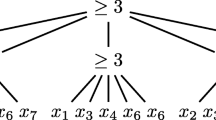Abstract
The elements of a finite setX (of odd cardinalityn) are divided into two (as yet unknown) classes and a member of the larger class is to be identified. The basic operation is to test whether two objects are in the same class. We show thatn-B(n) comparisons are necessary and sufficient in worst case, whereB(n) is the number of 1's in the binary expansion ofn.
Similar content being viewed by others
References
M. R. Best, P. van Emde Boas, andH. W. Lenstra,Jr.: A sharpened version of the Anaderaa-Rosenberg conjecture,Math. Centrum, Amsterdam 1974.
B. Bollobás:Extremal Graph Theory, Academic Press, 1978.
M. J. Fisher, andS. L. Salzberg: Finding a majority amongn voters,Journal of Algorithms,3 (1982), 375–379.
J. Misra, andD. Gries: Finding repeated elements,Science of Computer Programming,2 (1982), 143–152.
R. Rivest, andJ. Viullemin: On recognizing graph properties from adjacency matrices.Theor. Comp. Sci. 3 (1976/77), 371–384.
Author information
Authors and Affiliations
Additional information
Supported in part by NSF grant DMS87 03541 and Air Force Office of Scientific Research grant AFOSR-0271.




